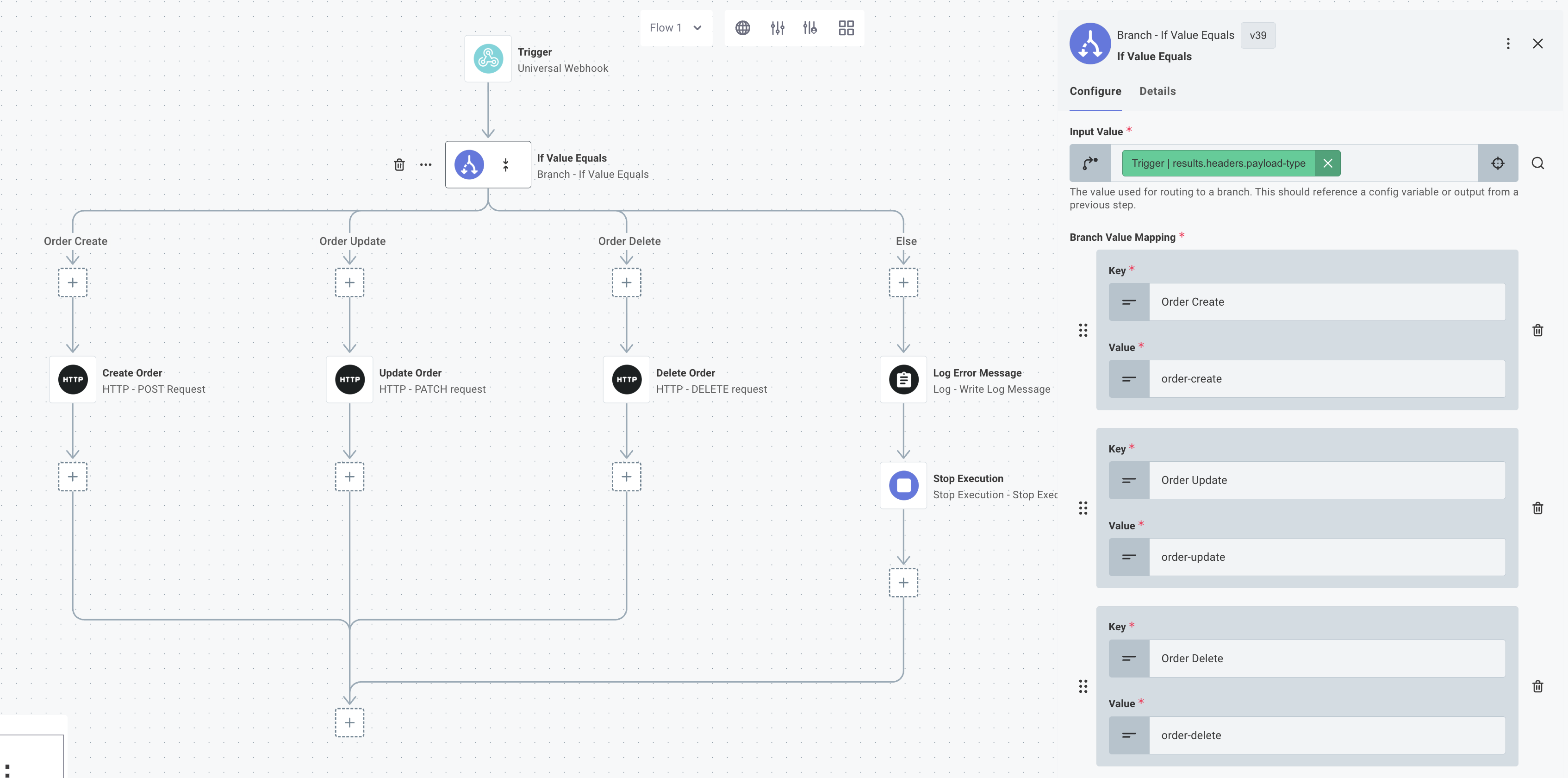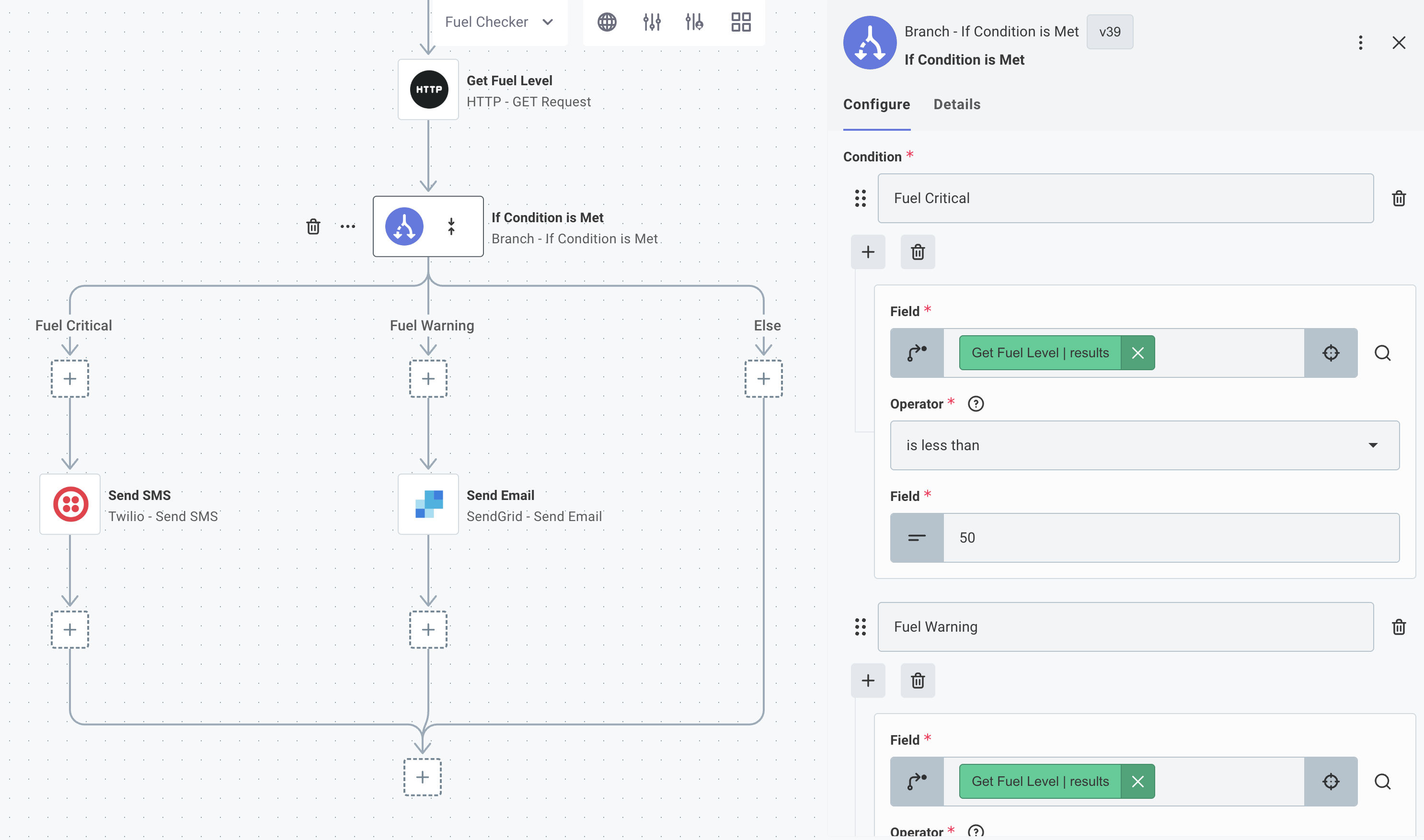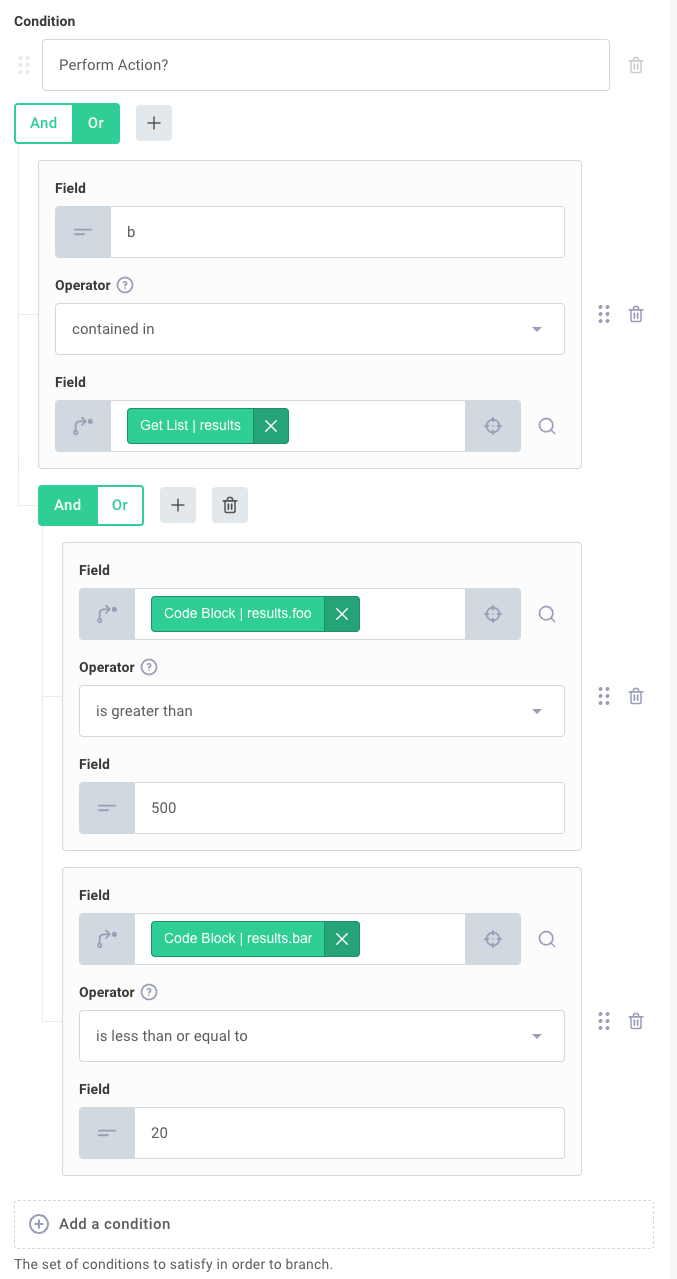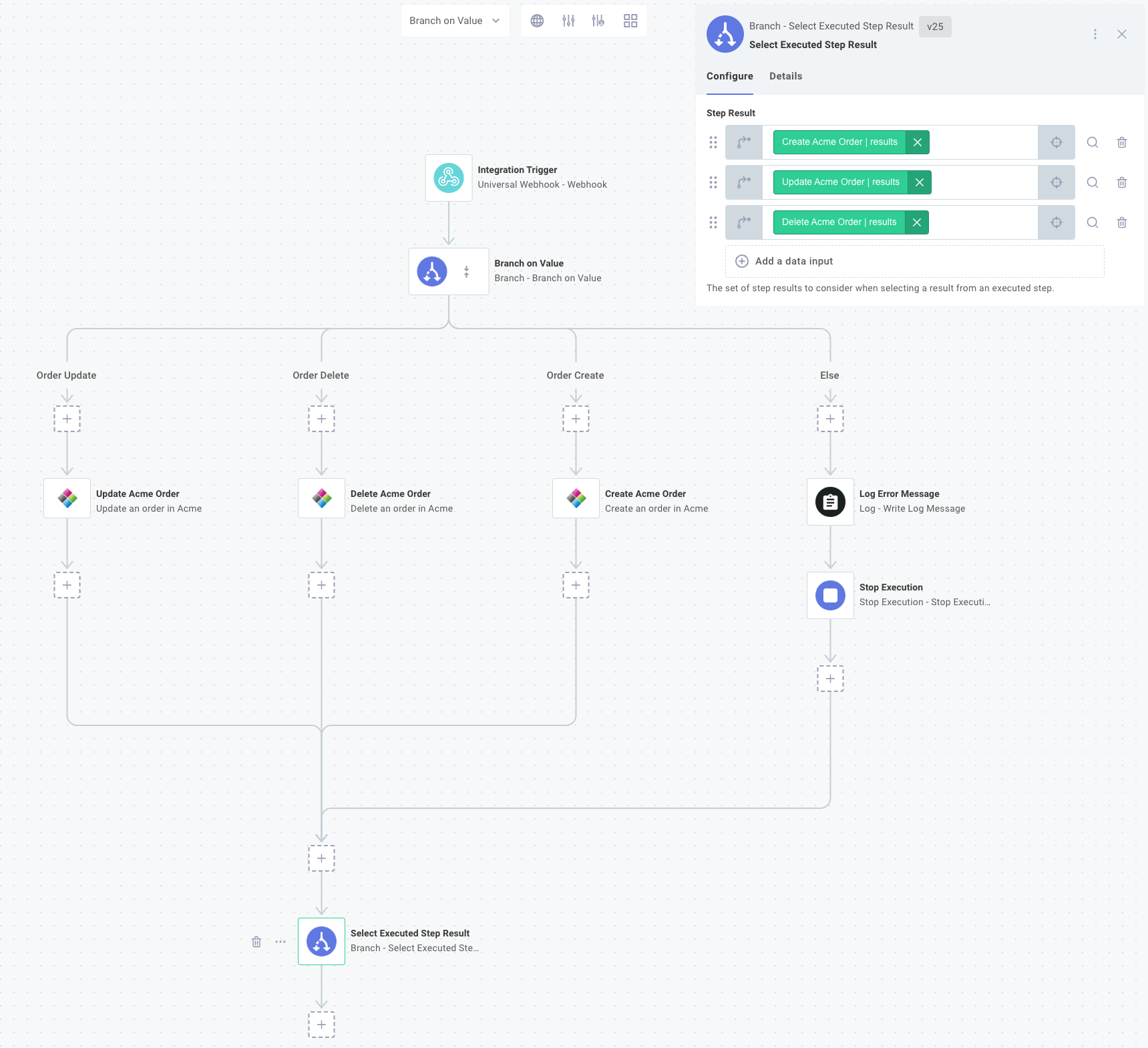Branching
The branch component allows you to add branching logic to your integration. Think of branches as logical paths that your integration can take. Given some information about config variables or step results, your integration can follow one of many paths.
Branch actions are useful when you need to conditionally execute some steps. Here are a couple of examples of things you can accomplish with branching:
Example 1: The webhook request your integration receives could contain an "Order Created", "Order Updated", or "Order Deleted" payload. You need to branch accordingly.
Example 2: Your customers want to be alerted when their rocket fuel level is below a certain threshold. You can branch into "send an alert" and "fuel level is okay" branches depending on results of a "check rocket fuel level" step.
Example 3: You want to upsert data into a system that doesn't support upsert. You can check if a record exists and branch into "add a new record" or "update the existing record" branches depending on whether the record exists.
For More Information: The Branch Component,
Branching on a value
Adding an If Value Equals action to your integration allows you to create a set of branches based on the value of some particular variable. It's very similar to the switch/case construct present in many programming languages.
Consider Example 1 above.
Suppose the webhook request you receive has a header, payload-type, that can be one of three values: order-create, order-update, or order-delete.
You can look at that value and branch accordingly.

For More Information: Branch If Value Equals action
Branching if a condition is met
The If Condition is Met action allows you to create branches within your integration based on more complex inputs. You can compare values, like config variables, step results, or static values, and follow a branch based on the results of the comparisons.
Consider Example 2 above. You have a step that checks rocket fuel level for a customer, and you want to alert users in different ways if their fuel levels are low. You can express this problem with some pseudocode:
if fuelLevel < 50:
sendAnSMS()
else if fuelLevel < 100:
sendAnEmail()
else:
doNothing()
To express this pseudocode in an integration, add a step that looks up rocket fuel level. Then, add an If Condition is Met action to your integration.
Create one branch named Fuel Critical and under Condition Inputs check that results of the fuel level check step is less than 50.
Then, create another branch named Fuel warning and check that results of the fuel level check step is less than 100.
This will generate a branching step that will execute the branch Send Alert SMS if fuel levels are less than 50, Send Warning Email if fuel levels are less than 100, or will follow the Else branch if fuel levels are 100 or above.

Branch if condition is met operators
You can compare config variables, results from previous steps, or static values to one another using a variety of comparison operators.
These operators each evaluate to true or false and can be chained together with And and Or clauses.
Equals branch operator
The equals operator evaluates if two fields are equal to one another, regardless of type.
| Left Field | Right Field | Result | Comments |
|---|---|---|---|
5.2 | 5.2 | true | |
5.2 | 5 | false | |
"5.2" | 5.2 | true | Strings are cast to numbers when compared to numbers |
"Hello" | "Hello" | true | |
"Hello" | "hello" | false | String comparison is case-sensitive |
false | 0 | true | Boolean false evaluates to 0, and true evaluates to 1. |
[1,2,3] | [1,2,3] | true | Arrays whose elements are the same are considered equal |
{"foo":"bar"} | {"foo":"bar"} | true | Objects with the same keys/values are equal |
Does not equal branch operator
The does not equal operator evaluates if two fields are not equal to one another, regardless of type.
| Left Field | Right Field | Result |
|---|---|---|
5.3 | 5.2 | true |
[1,2,3] | [1,2,4] | true |
Is greater than branch operator
The is greater than operator evaluates if the left field is greater than the right field and is an implementation of the JavaScript greater than operator.
| Left Field | Right Field | Result | Comments |
|---|---|---|---|
5.2 | 5.3 | false | |
5.3 | 5.3 | false | The values are equal; one is not greater than the other |
"5.3" | 5.2 | true | Strings are cast to numbers when compared to numbers |
"Hello" | "World" | false | Strings are compared alphabetically - "Hello" does not occur after "World" |
"hello" | "World" | true | The ASCII value for "h" occurs after "W" |
true | false | true | true (1) is greater than false (0) |
Is greater than or equal to branch operator
The is greater than or equal to operator is similar to is greater than but also returns true if the values being compared are equal to one another.
| Left Field | Right Field | Result | Comments |
|---|---|---|---|
5.3 | "5.3" | true | Strings are cast to numbers when compared to numbers |
Is less than branch operator
The is less than operator evaluates if the left field is less than the right field.
| Left Field | Right Field | Result | Comments |
|---|---|---|---|
3 | 4 | true | |
"abc" | "daa" | true | "a" is less than "d" alphabetically |
Is less than or equal to branch operator
The is less than or equal to operator is similar to is less than but also returns true if the values being compared are equal to one another.
Contained in branch operator
The contained in operator evaluates if the value of the left field is contained in the right field. The right field must be an array or a string.
| Left Field | Right Field | Result | Comments |
|---|---|---|---|
"world" | "Hello, world!" | true | |
"World" | "Hello, world!" | false | String comparison is case-sensitive |
2 | [1,2,3] | true | |
"2" | [1,2,3] | false | The string "2" does not occur in the array of numbers [1,2,3] |
Not contained in branch operator
The not contained in operator evaluates if the value of the left field does not appear in the right field.
| Left Field | Right Field | Result |
|---|---|---|
2 | [1,2,3] | false |
'Hi' | 'Hello' | true |
Is empty branch operator
The is empty operator evaluates if the given value is an empty string or an empty array.
| Field | Result |
|---|---|
"" | true |
"hello" | false |
[] | true |
[1,2,3] | false |
Exactly matches branch operator
The exactly matches operator evaluates if the two fields are equal to one another, taking the type of the values into consideration.
| Left Field | Right Field | Result | Comments |
|---|---|---|---|
"5" | 5 | false | The string "5" is not equal to the number 5 |
Does not exactly match branch operator
The does not exactly match operator evaluates if the two fields are not equal to one another, taking the type of the values into consideration.
| Left Field | Right Field | Result | Comments |
|---|---|---|---|
"5" | 5 | true | The string "5" is not equal to the number 5 |
Starts the string branch operator
The starts the string operator evaluates if the right field's value begins with the left field's value. Both right and left values must be strings.
| Left Field | Right Field | Result | Comments |
|---|---|---|---|
"Test" | "Testing Value" | true | |
"test" | "Testing Value" | false | Comparisons are case-sensitive |
"Test" | "A Testing Value" | false | The right field must start with (not contain) the left value |
Does not start the string branch operator
The does not start the string operator returns the opposite of the starts with operator.
Ends the string branch operator
The ends the string operator evaluates if the right field ends with the left field. Both right and left values must be strings.
| Left Field | Right Field | Result |
|---|---|---|
orld! | Hello, World! | true |
orld | Hello, World! | false |
Does not end the string branch operator
The does not end the string operator returns the opposite of the ends with operator.
The following three comparison operators accept date/times as ISO strings (like 2021-03-20 or 2021-03-20T11:52:21.881Z), Unix epoch timestamps in milliseconds (for example, the number 1631568050 represents a time in 2021-09-13), or Date() JavaScript objects.
Is after (date/time) branch operator
The is after (date/time) operator attempts to parse the left and right fields as dates and evaluates if the left field occurs after the right field.
| Left Field | Right Field | Result | Comments |
|---|---|---|---|
"2021-03-20" | "2021-04-13" | false | |
"2021-03-20T12:50:30.105Z" | "2021-03-20T11:52:21.881Z" | true | When dates are equivalent, time is compared |
"2021-03-20" | 1631568050 | false | 1631568050 is the UNIX epoch time for 2021-09-13, which occurs after 2021-03-05 |
Is before (date/time) branch operator
The is before (date/time) operator attempts to parse the left and right fields as dates and evaluates if the left field occurs before the right field.
Is the same (date/time) branch operator
The is the same (date/time) operator attempts to parse the left and right fields as dates and evaluates if the timestamps are identical.
| Left Field | Right Field | Result | Comments |
|---|---|---|---|
"2021-03-20T12:50:30.105Z" | "2021-03-20T12:50:30.105Z" | true | |
"2021-03-20T12:50:30Z" | 1616244630000 | true | 1616244630 is the millisecond UNIX epoch representation of March 20, 2021 12:50:30 |
"2021-03-20T12:50:30Z" | "2021-03-20T12:50:31Z" | false |
Is true branch operator
The is true operator evaluates if an input field is "truthy".
Common "truthy" values include true, "true", "True", "Yes", "yes", "Y", and "y".
Common "falsy" values include false, "false", "False", "No", "no", "N", and "n" and evaluate to false.
Other values that evaluate to false are 0, null, undefined, NaN, and "".
All other values (a non-zero number, a non-empty string, any array or object, etc.) evaluate to true.
| Field | Result |
|---|---|
"Yes" | true |
"True" | true |
[] | true |
{} | true |
"Hello" | true |
-5 | true |
"n" | false |
false | false |
"" | false |
null | false |
0 | false |
Is false branch operator
The is false operator returns the opposite of the is true operator.
Does not exist branch operator
The does not exist operator evaluates to true if the presented value is one of the following: undefined, null, 0, NaN, false or "".
| Field | Result |
|---|---|
undefined | true |
NaN | true |
1 | false |
"Hello" | false |
Exists branch operator
The exists operator returns the opposite of the does not exist operator.
Combining multiple comparison operators
Multiple expressions can be grouped together with And or Or clauses, which execute like programming and and or clauses. Take, for example, this programming expression:
if ((foo > 500 and bar <= 20) or ("b" in ["a","b","c"]))
The same logic can be represented with a group of conditionals in an If Condition is Met action:

For More Information: If Condition is Met action
Converging branches
Regardless of which branch is followed, branches always converge to a single point. Once a branch has executed, the integration will continue with the next step listed below the branch convergence.
This presents a problem: how do steps below the convergence reference steps in branches that may or may not have executed (depending on which branch was followed)? In your integration you may want to say "if branch foo was executed, get the results from step A, and if branch bar was executed, get the results instead from step B." Prismatic provides the Select Executed Step Result to handle that scenario.
Imagine that you have two branches - one for incoming invoices, and one for outgoing invoices, with different logic contained in each. Regardless of which branch was executed, you'd like to insert the resulting data into an ERP. You can leverage the Select Executed Step Result action to say "get me the incoming or outgoing invoice - whichever one was executed." This action iterates over the list of step results that you specify, and returns the first one that has a non-null value (which indicates that it ran).

Within the component configuration drawer, select the step(s) whose results you would like, and the Select Executed Step Result step will yield the result of whichever one was executed.